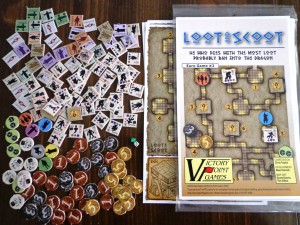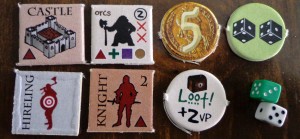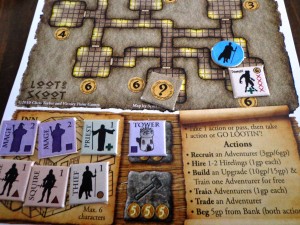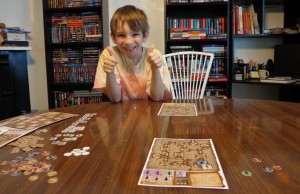I’ve never been a hardcore RPG board game player…as appealing as it is to create a character and assign all of these stats to them, I disliked how long it could sometimes take to resolve a game. Some people enjoy one long, epic experience while others like being able to have their quick fix without committing too much time out of their day.
Loot and Scoot is certainly the latter…that is…a quick dungeon crawler that tasks players with looting treasure and fighting monsters inside other players’ dungeons. Before we get started with the rules, gameplay, and all of the usual jazz, I’d like to once again thank Stephanie Marroquin from Victory Point Games for sending me a free copy to review.
Components
Dungeon / Inn Card – Each player receives one of these cards, though they can be described as small player boards as they hold the makings of a dungeon for players to explore, an inn for their party members, and a space for any upgrades that they may have purchased.
Room Tiles – Room tiles are placed face down on dungeons and represent the wonders (and dangers) that players will be facing in their quest for loot and victory points.
Adventurers – Players will be forming their party in the form of adventurers, who are made up of four different classes. They can be upgraded once to become more powerful, though none of them have special abilities…rather, only some of the classes can attack certain monsters.
Hirelings – If adventurers are your Kirk, Spock, and McCoy, then hirelings are your redshirts. They can make up part of a player’s party and take damage so that adventurers can keep going.
Money – Gold pieces are the form of currency in this game and is used to purchase upgrades, adventurers, and hirelings.
Dice & Divine Pity Markers – Divine pity markers are given to players when their luck in a dungeon ends before it even begins, adding two dice to their first normal combat roll during their next dungeon run. The manual states that players will need to provide their own dice to play this game, more on that in the review.
Setup & Gameplay
Each player receives a dungeon / inn card, five gold, two hirelings, a random face down boss tile, three random face down room tiles, and gets to pick two level one adventures of different classes. The starting player is chosen randomly.
Next, players seed their dungeon with tiles, one at a time in turn, drawing a new face down tile after every tile placement. The number of rooms that are filled in this manner depends on how many players are playing the game.
A player can take two actions every turn. The type of actions that they can take consists of the following:
Recruit an Adventurer – A player can recruit a level one adventurer at three gold or six gold a piece, depending on how many of that class they currently have in their possession. Players can’t own more than two adventurers of the same class…for example, you couldn’t have three squires.
Hire Hirelings – Hirelings cost one gold to hire and count towards your party limit. A player can not have more than six characters (adventurers and hirelings) in their party.
Beg Funds – A player can sacrifice both available actions to perform this one, which gives the player five gold from the bank.
Build an Upgrade – Players can pay ten and fifteen gold for their first and second upgrade, respectively. Upgrades allow players to train adventurers of a particular class. Building an upgrade allows the player to train one adventurer of the appropriate class for free.
Train Adventurers – Adventurers can be trained for one gold a piece, assuming that they have the appropriate upgrade to do so. You can pay other players to train your adventurers at their upgrade buildings, the cost being negotiated as these instances occur.
Go a-Lootin’ – A player can choose to explore an opponent’s dungeon (never their own). They’ll be exploring room tiles, which consist of treasures (in which they roll for gold), poison (in which they roll for a poison check), and monsters (which players will fight). Some monster tiles allow players to collect loot in the form of victory point markers when they are defeated. Finally, each dungeon contains a boss…the game ends when one player finds and defeats a boss in an opponent’s dungeon.
Combat is pretty straight forward. Room tiles that contain monsters list particular class symbols…for every matching symbol that is in a player’s party, they get to roll one die. Divine pity markers add two more dice to this combat roll. In most cases, rolling a six defeats the monster, though there are exceptions to the rule. Each monster tile has wound indicators on them, instructing players as to how many wounds are inflicted on your party members if the overall dice roll ends up being bad.
Once a boss is defeated, players count up their victory point markers, subtract one point per poison marker, add in any unclaimed dungeon tiles in their own dungeon as well as figure in money earned at a ratio of one victory point per five gold. The person with the most victory points at the end of the game wins!
The above overview leaves out a few things, but should still give you an idea of what the game is like. If you’d like to learn more, you can view the manual here:
The Review
The components do a good job in keeping things simple. I had no trouble understanding what each tile did, based on the symbols that appeared on them. I personally appreciate how the dungeon / inn cards contain a list of the actions a player can take, saving me from having to glance at the manual from time to time. The game is fairly dice heavy and the fact that no regular sized dice are included in the game is a bit disappointing. You’ll be using dice often, so be sure that you have an extra set available. Two small gift die were included, but I was partially unable to use them and relied on my son to read off the numbers for me.
While the game does involve a bit of luck, I like the inclusion of the divine pity mechanic. It helps to reduce the amount of time a player might find themselves stuck due to a bad streak of dice rolls, which is always a plus. There is a little bit of strategy involved, especially when designing your dungeon in the very beginning. While it is true that you are limited to the tiles you draw and have in your hand, you have free reign in placing them. Making sure that your opponents encounter poison by placing it strategically and on the likely route to your boss tile, for example, is one such consideration. Each room in your dungeon has a level associated with it, giving your opponents an idea of what might be located there. While monsters who are higher in level than the room level they are placed in receive a combat penalty, a player may want to psych their opponents out by placing the boss in an out of the way room that might not be so obvious. Whether it’s wise to do so is another story, but players have the option regardless.
I could tell that Vinnie (11) was having a good time exploring my dungeon. He is naturally lucky with dice, so he was able to roll sixes and defeat my monsters without being stuck on one for too long. We both found ourselves having to run from monsters that could only be attacked by classes that weren’t in our parties yet…luckily, the dungeons branch off a lot and you are able to get to other rooms without having to pass a particular one (in most cases).
Loot and Scoot is a fun, casual dungeon crawler experience. There are other dungeon crawlers out there that go in to greater detail and are much more complex, but this game proves that you don’t need a long, complex dungeon crawler to have a good time with friends and family. If you don’t mind a light, semi-luck driven dungeon crawler, then give this game a shot!
Final Verdict: 7/10
You can find more information on “Loot and Scoot” by visiting the Victory Point Games website or on Board Game Geek, located here:




